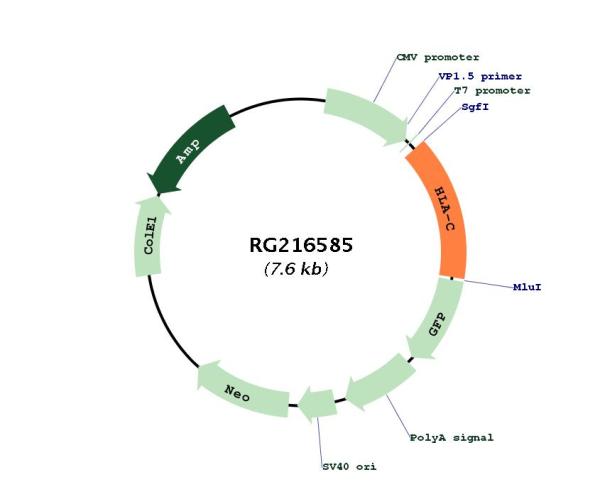HLAC (HLA-C) (NM_002117) Human Tagged ORF Clone
CAT#: RG216585
- TrueORF®
HLA (tGFP-tagged) - Human major histocompatibility complex, class I, C (HLA-C)
ORF Plasmid: DDK
Lentiviral Particles: DDK w/ Puro mGFP w/ Puro
AAV Particle: DDK
"NM_002117" in other vectors (4)
Specifications
| Product Data | |
| Type | Human Tagged ORF Clone |
| Tag | TurboGFP |
| Symbol | HLAC |
| Synonyms | D6S204; HLA-JY3; HLAC; HLC-C; MHC; PSORS1 |
| Vector | pCMV6-AC-GFP |
| E. coli Selection | Ampicillin (100 ug/mL) |
| Mammalian Cell Selection | Neomycin |
| Sequence Data |
>RG216585 representing NM_002117
Red=Cloning site Blue=ORF Green=Tags(s) TTTTGTAATACGACTCACTATAGGGCGGCCGGGAATTCGTCGACTGGATCCGGTACCGAGGAGATCTGCC GCCGCGATCGCC ATGCGGGTCATGGCGCCCCGAGCCCTCCTCCTGCTGCTCTCGGGAGGCCTGGCCCTGACCGAGACCTGGG CCTGCTCCCACTCCATGAGGTATTTCGACACCGCCGTGTCCCGGCCCGGCCGCGGAGAGCCCCGCTTCAT CTCAGTGGGCTACGTGGACGACACGCAGTTCGTGCGGTTCGACAGCGACGCCGCGAGTCCGAGAGGGGAG CCGCGGGCGCCGTGGGTGGAGCAGGAGGGGCCGGAGTATTGGGACCGGGAGACACAGAAGTACAAGCGCC AGGCACAGGCTGACCGAGTGAGCCTGCGGAACCTGCGCGGCTACTACAACCAGAGCGAGGACGGGTCTCA CACCCTCCAGAGGATGTCTGGCTGCGACCTGGGGCCCGACGGGCGCCTCCTCCGCGGGTATGACCAGTCC GCCTACGACGGCAAGGATTACATCGCCCTGAACGAGGACCTGCGCTCCTGGACCGCCGCGGACACCGCGG CTCAGATCACCCAGCGCAAGTTGGAGGCGGCCCGTGCGGCGGAGCAGCTGAGAGCCTACCTGGAGGGCAC GTGCGTGGAGTGGCTCCGCAGATACCTGGAGAACGGGAAGGAGACGCTGCAGCGCGCAGAACCCCCAAAG ACACACGTGACCCACCACCCCCTCTCTGACCATGAGGCCACCCTGAGGTGCTGGGCCCTGGGCTTCTACC CTGCGGAGATCACACTGACCTGGCAGCGGGATGGGGAGGACCAGACCCAGGACACCGAGCTTGTGGAGAC CAGGCCAGCAGGAGATGGAACCTTCCAGAAGTGGGCAGCTGTGGTGGTGCCTTCTGGACAAGAGCAGAGA TACACGTGCCATATGCAGCACGAGGGGCTGCAAGAGCCCCTCACCCTGAGCTGGGAGCCATCTTCCCAGC CCACCATCCCCATCATGGGCATCGTTGCTGGCCTGGCTGTCCTGGTTGTCCTAGCTGTCCTTGGAGCTGT GGTCACCGCTATGATGTGTAGGAGGAAGAGCTCAGGTGGAAAAGGAGGGAGCTGCTCTCAGGCTGCGTGC AGCAACAGTGCCCAGGGCTCTGATGAGTCTCTCATCACTTGTAAAGCC ACGCGTACGCGGCCGCTCGAG - GFP Tag - GTTTAA >RG216585 representing NM_002117
Red=Cloning site Green=Tags(s) MRVMAPRALLLLLSGGLALTETWACSHSMRYFDTAVSRPGRGEPRFISVGYVDDTQFVRFDSDAASPRGE PRAPWVEQEGPEYWDRETQKYKRQAQADRVSLRNLRGYYNQSEDGSHTLQRMSGCDLGPDGRLLRGYDQS AYDGKDYIALNEDLRSWTAADTAAQITQRKLEAARAAEQLRAYLEGTCVEWLRRYLENGKETLQRAEPPK THVTHHPLSDHEATLRCWALGFYPAEITLTWQRDGEDQTQDTELVETRPAGDGTFQKWAAVVVPSGQEQR YTCHMQHEGLQEPLTLSWEPSSQPTIPIMGIVAGLAVLVVLAVLGAVVTAMMCRRKSSGGKGGSCSQAAC SNSAQGSDESLITCKA TRTRPLE - GFP Tag - V |
| Restriction Sites |
SgfI-MluI
Cloning Scheme for this gene
Plasmid Map

|
| ACCN | NM_002117 |
| ORF Size | 1098 bp |
| OTI Disclaimer | The molecular sequence of this clone aligns with the gene accession number as a point of reference only. However, individual transcript sequences of the same gene can differ through naturally occurring variations (e.g. polymorphisms), each with its own valid existence. This clone is substantially in agreement with the reference, but a complete review of all prevailing variants is recommended prior to use. More info |
| OTI Annotation | This clone was engineered to express the complete ORF with an expression tag. Expression varies depending on the nature of the gene. |
| Product Components | The ORF clone is ion-exchange column purified and shipped in a 2D barcoded Matrix tube containing 10ug of transfection-ready, dried plasmid DNA (reconstitute with 100 ul of water). |
| Reconstitution | 1. Centrifuge at 5,000xg for 5min. 2. Carefully open the tube and add 100ul of sterile water to dissolve the DNA. 3. Close the tube and incubate for 10 minutes at room temperature. 4. Briefly vortex the tube and then do a quick spin (less than 5000xg) to concentrate the liquid at the bottom. 5. Store the suspended plasmid at -20°C. The DNA is stable for at least one year from date of shipping when stored at -20°C. |
| Reference Data | |
| RefSeq | NM_002117.6 |
| RefSeq Size | 1543 bp |
| RefSeq ORF | 1101 bp |
| Locus ID | 3107 |
| UniProt ID | P10321 |
| Cytogenetics | 6p21.33 |
| Domains | MHC_I, ig, IGc1 |
| Protein Families | Secreted Protein, Transmembrane |
| Protein Pathways | Allograft rejection, Antigen processing and presentation, Autoimmune thyroid disease, Cell adhesion molecules (CAMs), Endocytosis, Graft-versus-host disease, Natural killer cell mediated cytotoxicity, Type I diabetes mellitus, Viral myocarditis |
| Gene Summary | HLA-C belongs to the HLA class I heavy chain paralogues. This class I molecule is a heterodimer consisting of a heavy chain and a light chain (beta-2 microglobulin). The heavy chain is anchored in the membrane. Class I molecules play a central role in the immune system by presenting peptides derived from endoplasmic reticulum lumen. They are expressed in nearly all cells. The heavy chain is approximately 45 kDa and its gene contains 8 exons. Exon one encodes the leader peptide, exons 2 and 3 encode the alpha1 and alpha2 domain, which both bind the peptide, exon 4 encodes the alpha3 domain, exon 5 encodes the transmembrane region, and exons 6 and 7 encode the cytoplasmic tail. Polymorphisms within exon 2 and exon 3 are responsible for the peptide binding specificity of each class one molecule. Typing for these polymorphisms is routinely done for bone marrow and kidney transplantation. About 6000 HLA-C alleles have been described. The HLA system plays an important role in the occurrence and outcome of infectious diseases, including those caused by the malaria parasite, the human immunodeficiency virus (HIV), and the severe acute respiratory syndrome coronavirus (SARS-CoV). The structural spike and the nucleocapsid proteins of the novel coronavirus SARS-CoV-2, which causes coronavirus disease 2019 (COVID-19), are reported to contain multiple Class I epitopes with predicted HLA restrictions. Individual HLA genetic variation may help explain different immune responses to a virus across a population.[provided by RefSeq, Aug 2020] |
Documents
| Product Manuals |
| FAQs |
| SDS |
Resources
Other Versions
| SKU | Description | Size | Price |
|---|---|---|---|
| RC216585 | HLA (Myc-DDK-tagged)-Human major histocompatibility complex, class I, C (HLA-C) |
USD 457.00 |
|
| RC216585L3 | Lenti ORF clone of Human major histocompatibility complex, class I, C (HLA-C), Myc-DDK-tagged |
USD 757.00 |
|
| RC216585L4 | Lenti ORF clone of Human major histocompatibility complex, class I, C (HLA-C), mGFP tagged |
USD 757.00 |
|
| SC118843 | HLA (untagged)-Human major histocompatibility complex, class I, C (HLA-C) |
USD 457.00 |
{0} Product Review(s)
Be the first one to submit a review






























































































































































































































































 Germany
Germany
 Japan
Japan
 United Kingdom
United Kingdom
 China
China

